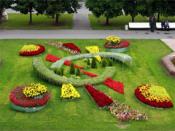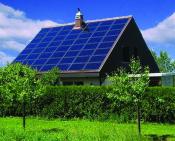Search
Login
What seeds are planted in seedlings in February? Growing seedlings in February: peppers, tomatoes, eggplant, leeks, celery, flowers. Lunar calendar of sowing and planting, preparation of the earth, watering and fertilizing.
Gardeners know that February is the month when sowing seeds of some vegetables and ornamental plants should begin. Of course, you should not sow everything. We pay attention to cultures whose development has certain features.
Content:
- What can be planted in February for seedlings? video
- What seedlings to plant in February, how to calculate the timing of sowing
- When to plant pepper in February 2018
- Lunar calendar planting seedlings for February 2018
- Vegetable seedlings in February - when to plant tomatoes and eggplant video
- Preparing the land for seedlings
- Some useful tips
- February - do not forget to sow leek and celery
- What flower seedlings to plant in February video
- Do you need seed dressing, how, when and how to carry it out
What can be planted in February for seedlings?
Selecting seeds for the February sowing should be guided by the following rules and select:
- vegetable crops with a long growing season
- perennial plants whose tuber development is slow
- seeds with long germination periods and slow emergence of seedlings

Maximum attention should be paid to seed quality; this factor is very important in determining the growing season.
Before sowing seeds for seedlings, do not forget about the need to treat them with antifungal agents Maxim, Vitaros, Fitosporin-M. Soil will also need to be prepared, sowing work can only be done when the soil warms up well, i.e. bring it into the room in advance.
What seedlings to plant in February, how to calculate the timing of sowing
Starting calculations, we take into account that the seed germination period is individual for each of their crops, before emergence, it will be required:
- for seeds of salad pepper and burning - about two weeks
- tomatoes - about 10 days
- chernushka onions from 10 to 12 days
- eggplant - about 10 days, maybe more
- two to three weeks leek
- kohlrabi and white cabbage - from 7 to 10 days
- color will rise soon - within a week
- celery and rhubarb - about 2 weeks
- cucumbers, zucchini, pumpkins - about 10 days
- melons - 7 days
- lettuce - 10 days
To determine the timing of sowing, you will also need to consider at what age it is recommended to plant seedlings:
- from 60 to eighty days, you will need to take care of celery seedlings
- a little less, about 65-70 - for seedlings of eggplant and onion from chernushka
- peppers and tomatoes will be ready for planting 60 days after emergence
- cabbage - after 50
- cucumbers and zucchini grow faster, you can plant them in 30-40 days
In order not to be mistaken in the calculations, you can use a very simple formula:
date of sowing seeds \u003d date of intended planting in a greenhouse or open ground - (the number of days that will be required to obtain seedlings + the number of days for the development of a full-fledged seedling).

When to plant pepper in February 2018
It is difficult to indicate the exact date, because you will need to take into account the region of residence, the timing of planting seedlings in open-air beds can vary significantly for different areas. But the following conclusions will help determine the date.
The optimum temperature for the development of seedlings of pepper is slightly higher than for tomatoes, therefore, it can be sown a little later.
The opinion of agronomists about the optimal timing of pepper planting, for example, in the conditions of the Kuban:
- in unheated greenhouses - from April 4 to April 24
- in open beds - from April 25 to May 10
For the middle band, these terms are shifted:
- for greenhouses - April 29 - May 20
- for beds in the open air - May 20 - June 10

If you use the proposed calculation formula, it turns out that for the southern regions, for example - the same Kuban, for landing:
- in the greenhouse, seeds for seedlings are recommended to be sown from January 20 to 25
- in the open air beds - from February 1 to March 3
For the middle band, the timing, given the more severe weather conditions, will be completely different, it is recommended to sow the seeds:
- for greenhouse growing conditions - from February 19 to March 11
- open ground - from March 11 to April 1
Lunar calendar planting seedlings for February 2018

Do not forget that it is desirable to coordinate the calculated dates with the lunar calendar of the gardener for 2018. It turns out that the southerners are best at sowing peppers for seedlings:
- for greenhouses at the very end of January, 29 or 30
- for open ground - at the end of February, the 25th or 26th.
If you were talking about amateur vegetable growers in central Russia, the following terms are recommended:
- for greenhouse seedlings February 25 or 26
- for seedlings in the beds - March 30 or 31.
In the calculation, it was necessary to take into account the moment that the first half of April according to the lunar calendar is a period unfavorable for planting seeds.

Useful advice for beginner gardeners! Pepper is distinguished by very thin and delicate roots, the process of picking it is a risky procedure. If possible, it is better to plant the seeds in individual cups, their diameter should be about 7-8 cm, you can also use peat tablets, provided that their diameter is not less than 4 cm.
Vegetable seedlings in February - when to plant tomatoes and eggplant
The calculation of the planting dates of eggplant, tomato and other vegetable crops is made in exactly the same way, taking into account the climatic conditions of your area of \u200b\u200bresidence.

For example, eggplant. They, like peppers, are thermophilic, that is, they can be planted only when the temperature of the air and soil is reached optimal for growing this crop. In the southern regions, seedlings are usually planted in the first decade of May.
We count back 70 days that are required for the development of the seedling, it turns out that the date of emergence of seedlings should be between 20.02 and 2.03. Since it takes at least 10 days to sprout, we count them on the calendar. It turns out that sowing seeds is recommended in the interval from February 12 to 18.

For the middle band, these dates can be shifted by about 2 weeks, because the real warmth there comes later.
In about a week, it is recommended to prepare containers or cups, check the seeds, and make land for seedlings.
Preparing the land for seedlings
How to choose the right soil for planting seeds, or prepare it yourself, we have already considered in the article What we plant in January, what flowers to plant in January for seedlings.
If the land is harvested independently, then take into account. what the best composition contains:
- 30% humus
- 40% sand
- 30% of chernozem from the site
It is not recommended to take soil from tomato or potato beds.

We sift each of the components of the soil mixture through a sieve or colander, this will remove pebbles, hard lumps, and random garbage. The resulting mixture can be treated with a chemical composition, or calcined in the oven. To enrich the soil mixture, you can use complex mineral supplements purchased in the store.
Observe the recommended dosage - required!
Finishing finished store substrates should not be.
Some useful tips
Of course, one does not have to talk about accuracy in calculations; one should approach them with a certain degree of criticality; it is best to consider them indicative. In addition to calculations, a long-term weather forecast should be taken into account, and not only in the spring, but also in the summer months. For example, significant adjustments will be required if April and May promise cold and rainy, if late spring frosts are expected.
In addition, if in case of sudden cooling in May it is necessary to postpone the planting dates to a later time, then there is a risk that tomato seedlings will outgrow. Cope with fragile, overgrown plants is much more difficult than with a few undergrown. Indeed, for a full-fledged seedling, it is sufficient to have 5-6 real leaves.

Beginners can recommend:
- be creative about the process of growing seedlings
- don't be afraid to experiment
- be guided in their actions by common sense
- track long-term and short-term weather forecasts, do not ignore the time-tested folk signs about the weather
February - do not forget to sow leek and celery
Both cultures have a long development period. Leek, moreover, is a two-year culture. Provided that high-quality seedlings are planted, you can get a good crop in one season.
It takes about 60 days from sowing seeds to transplanting seedlings into the ground. Since the plant is not very demanding on temperature, they practice planting it in the soil in early May.

For the development of celery in later varieties, approximately 200 days are required. Of course, the best option would be to plant it under open sky seedlings. Plant seeds will also need to be planted in February, then the seedlings will arrive in time by early May. Containers with seedlings should be placed on well-lit window sills; in case of cloudy days, illumination will not be superfluous.

Those who did not have time to sow elite potato and strawberry seeds in January should choose suitable days for sowing in February according to the lunar calendar and continue work. Potato seeds should first be sprouted. Sow in warmed soil. the best temperature for friendly shoots is + 24 C, it is advisable to take care of good lighting. Compliance with the specified temperature is recommended both in the daytime and at night.
Since even seed producers do not guarantee 100% germination, sowing is recommended to be made more dense.
What flower seedlings to plant in February
No amateur gardener will deny himself the cultivation of flowers on the site. It turns out to be a little expensive to buy seedlings in the spring, seedlings of some crops, even if you are ready to spend any money, can not be found at all.
Therefore, you should think ahead of time what kind of flowers you will grow next summer and get seeds. A huge assortment of them is offered by gardening stores, in specialized online stores you can find planting stock of any, even exotic crops, and you don’t even need to leave the house.
Viola
What to sow in February? Definitely, everyone's favorite pansies, or viola. Seeds are not deeply embedded in the soil. because they are very small.

The grown shoots dive into personal cups. Under favorable weather conditions and proper care in early June, you can already admire the bright delicate colors. To prevent stretching, the seedlings are kept at a temperature of +15 C.
Petunias
Elite varieties of petunias are often used to decorate porches, terraces and balconies.
Attract:
- her large, saturated colors flowers
- a wide variety of shades and varieties
- endurance
- the possibility of growing in a pot and flower beds
Small seeds of petunias are spread over the surface of the soil, covered with polyethylene or glass. Shoots should appear on about the tenth day.

The grown plants dive into separate pots or glasses, planted on a flowerbed in early summer. Its flowering continues almost until the onset of autumn frosts.
Lobelia
February is the best time to plant graceful lobelia seeds. Seeds are sown on moist soil, they are deepened, but do not fall asleep on top. The formation of the first sprouts will require at least two weeks. Dive plants are placed separately, they are prepared for planting in the 30th of May.

Carnations
In late January and early February, Shabo cloves are sown. The basis of proper care is moderate watering, warmth, high-quality lighting. Seedlings can be expected after 7 days, seedlings can be planted under the open sky in early June.
Begonias
Begonia is often used to decorate borders in a landscape garden. Since the time of germination is long, the seeds should be sown before the end of winter. Seeds are pressed to the ground, no need to fall asleep. You can plan a pick in a month and a half, you can plant in the ground in June.

Chrysanthemums
In order to get blooming chrysanthemums grown as perennials in early autumn, seeds are also recommended to be sown in February. The depth of embedding of planting material is 0.5 cm. Sprouts that appear after a week are kept in a lighted place, waiting until they get stronger - they are planted in separate pots. The soil is well moistened. At least two months will pass before planting on the flower beds.

Primrose
Even in February, primroses are sown, a feature of their cultivation is the placement of containers with crops at a fairly cool temperature for a month. Then they can be transferred to a warm and well-lit room. You can transplant seedlings into the ground at the end of May.
Lavender

Particular attention should be paid to lavender. Do not forget that the plant is perennial; growing it in open ground can be problematic. Therefore, experts recommend buying seeds narrow-leaved English lavendermore stable at low temperatures. She can survive the cold winters of the Middle Strip.
Seeds are sown in cold soil and kept in the cold for about a month. Then the pots can be transferred to a warm room.
You can dive only after the appearance of the third leaf, it is recommended to plant it in the ground during warming.
Delphiniums

To get the magnificent blooming of the delphinium in the summer, you will need to take care of its planting in mid-February. Seeds are deepened by about 2-3 mm in loose soil. Three to four weeks may elapse before sprouts appear. A plant with two leaves can already be dived, and after three weeks - planted in open ground.
Pelargonium
To a depth of about 5 mm, rather large pelargonium seeds are laid. It will take about a month to germinate. Saplings with two leaves are subject to picking, with the beginning of summer heat they are planted in open ground. Flowering lasts until late autumn.
Heicher
It is quite simple to grow a charming perennial geyher from seeds. She is very respected by landscape designers for a variety of shapes and colors, for a long flowering period from 50 to 60 days. Heichera seeds are enough to lay on loose moist soil, cover the pot with a film. To appear seedlings, the container is placed on a well-lit window sill.

The first sprouts appear after two weeks. After the appearance of the third leaf, you can begin to pick. The best time to land in the ground is mid-May.
Do you need seed dressing, how, when and how to carry it out
Experts recommend:
- use complete mineral complexes for top dressing
- it is possible to make top dressing no more than once every ten days
- it is advisable to alternate mineral fertilizing with preparations based on humus
- when growth is slowed down, nitrogen-containing fertilizer should be applied
- after applying fertilizer, clean water should follow
- the norm of nitrogen fertilizers - 5 g per 10 liters of water, complex - up to 10 g per 10 liters
- if the seedlings look bad, you should apply leaf dressing with trace elements

With slow growth, you should consider whether containers with plants are adequately lit. If necessary, it will be necessary to organize additional illumination with phytolamps.





